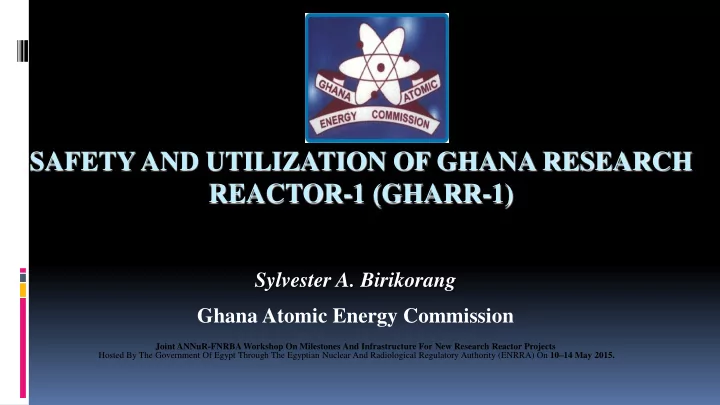

SAFETY AND UTILIZATION OF GHANA RESEARCH REACTOR-1 (GHARR-1) Sylvester A. Birikorang Ghana Atomic Energy Commission Joint ANNuR-FNRBA Workshop On Milestones And Infrastructure For New Research Reactor Projects Hosted By The Government Of Egypt Through The Egyptian Nuclear And Radiological Regulatory Authority (ENRRA) On 10–14 May 2015.
OUTLINE OF PRESENTATION Brief Background of Facility Leadership and Management for Safety IAEA mission in Ghana Modifications Control rod drive mechanism Installation of slant tube Core conversion Conclusion Joint ANNuR-FNRBA Workshop On Milestones And Infrastructure For New Research Reactor Projects Hosted By The Government Of Egypt Through The Egyptian Nuclear And Radiological Regulatory Authority (ENRRA) On 10–14 May 2015.
BRIEF DESCRIPTION OF GHARR-1FACILITY 1/3 Ghana Research Reactor-1 (GHARR-1 ) is an MNSR which can be classified as a low power research reactor. Tank-in-pool type reactor, water-moderated and cooled by natural convention The general principles of design and operation are similar to other low power research reactors as the Canadian SLOWPOKE 1& II (Safe LOW POwer CAritical (K) Experiments) The reactor is designed as a neutron source with maximum flux of 1x10 12 n/cm 2 .s with 10 irradiation tubes; 5 inside and 5 outside the beryllium annulus reflector. The reactor power is 30kW with core excess reactivity of approximately 4.0mk
BRIEF DESCRIPTION OF GHARR-1 FACILITY 2/3 The reactor fuel is compose of HEU (90.2%) fuel (U-Al) which is surrounded by annular Be reflectors Has one central Control Rod made of Stainless Steel Clad, Cadmium Absorber Uses: Research, NAA, HRD in nuclear technology Attained Criticality on December 17, 1994 and commissioned on March 1995 It has an average operational hours of 6hrs/day and 4 days/week
BRIEF DESCRIPTION OF GHARR-1 FACILITY 3/3
LEADERSHIP AND MANAGEMENT FOR SAFETY GHANA GOVERNMENT RADIATION PROTECTION BOARD (RPB) RADIATION REACTOR N N R I SAFETY SAFETY COMMITTEE COMMITTEE (Rad. SC) (RSC) REACTOR MANAGER (RM)
IAEA MISSION IN GHANA Ghana has been privileged to benefit from some INSAAR missions in the past. Concerns were raised by the experts on both security and safety measures, and most of the recommendations from these missions were adopted by management of the commission. A committee was set up to make sure the recommendations adopted recommendations are implemented. The committee relied on the IAEA safety standards with regards to our situation in reviewing existing standards.
PAST SAFETY AND SECURITY MEASURES: The center had no : turnstile smoke detectors list for dangerous materials security cameras detailed checklist and documentation characterization of zones pasting of posters indicating radioactive zones etc
MODIFICATIONS Processes that were previously not documented have been detailed Labeling of areas, objects have all been implemented Students from the graduate school of nuclear sciences jointly established by the GAEC, IAEA and University of Ghana and other undergraduate students who come for experiments are given the go ahead by the reactor manager without been going through the RSO or RSC Members of the public who come for excursion can gain permission to go on tour from the manager alone However , for commercial and research activities, clearance shall be given by the head of the neutron activation analysis group, the RSO and the reactor manager. In the absence of any of them, irradiation cannot take place
CHANGE OF CONTROL ROD DRIVE MECHANISM There have been some major modifications as well. The reactor control rod drive mechanism has been replaced Detailed procedure which were followed by the workers during the changing process was drafted and sent to the RSC for approval and recommendation. A license for modification was requested from the regulatory body In extension, the analogue control console was also change to a Micro Computer Closed Loop System.
INSTALLATION OF SLANT TUBE A slant tube has been installed to enable the center perform Large Sample Neutron Activation Analyses. Installation procedure was drafted and accepted by the RSC However, the regulatory authority raised concerns about calculations and results It was sent back to the group to make a more elaborate procedure and certain documents requested by the regulators was added. The to and fro between both parties went on for about three months before finally permission was given.
CORE CONVERTION The reactor core is to be converted from HEU to LEU and all calculation on the project is concluded However, the implementation presents an involving process Regulatory body is training staff in nuclear engineering to enable them fully understand and appreciate the core conversion process Series of meetings have gone on between the funding organization, core manufacturers, regulatory body and the operating organization to manage expectations and responsibilities of each party
All the requirement of the regulators have to be met. The safety analyses report is reviewed periodically to include these changes.
EMERGENCY PLAN In case of yearly maintenance or any special activity, dose monitoring is undertaken and results are well documented. (there is a special file for such activities) Drills and table top exercises are organized for non radiation staff yearly Plans are far advanced to have a fire station on site Apart from the fact that the emergency response unit is close to site, a permanent policeman, well trained in nuclear security and safety is always on site. New protective clothing and gears have been acquired
CONCLUSIONS Ghana has made a lot of effort in improving safety conditions, however, within the constraints of insufficient funding, we can only hope for the best. Management is keen on further improving the situation with help from government of Ghana, IAEA, DOE and other organizations. The future looks bright and we can only do better.
THANKS FOR YOUR ATTENTION
Recommend
More recommend